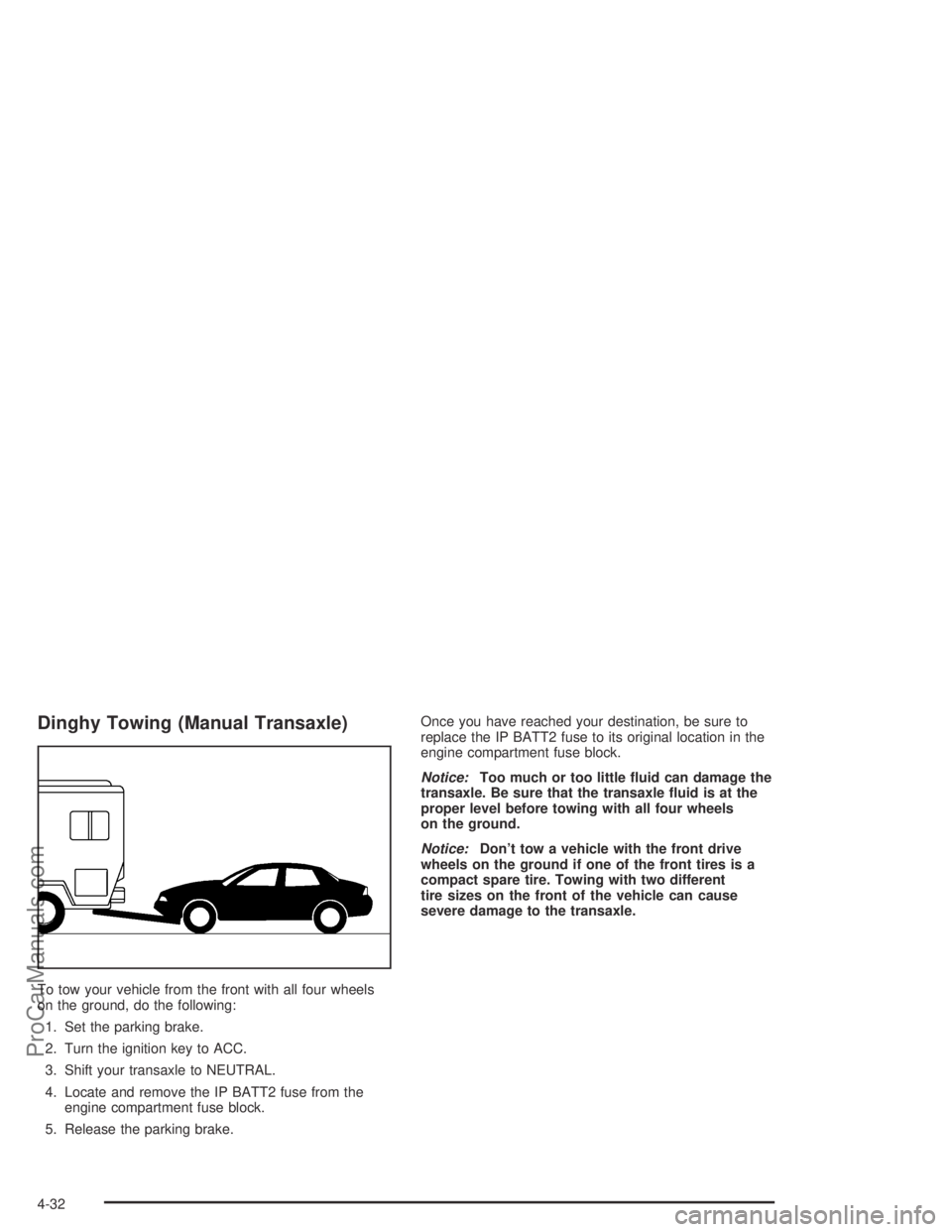lock SATURN ION 2004 Repair Manual
[x] Cancel search | Manufacturer: SATURN, Model Year: 2004, Model line: ION, Model: SATURN ION 2004Pages: 380, PDF Size: 2.89 MB
Page 199 of 380

While driving on a surface with reduced traction, try
your best to avoid sudden steering, acceleration
or braking (including engine braking by shifting to a
lower gear). Any sudden changes could cause the tires
to slide. You may not realize the surface is slippery
until your vehicle is skidding. Learn to recognize warning
clues — such as enough water, ice or packed snow
on the road to make a “mirrored surface” — and slow
down when you have any doubt.
If you have the anti-lock braking system, remember:
It helps avoid only the braking skid. If you do not have
anti-lock, then in a braking skid (where the wheels
are no longer rolling), release enough pressure on the
brakes to get the wheels rolling again. This restores
steering control. Push the brake pedal down steadily
when you have to stop suddenly. As long as the wheels
are rolling, you will have steering control.Driving at Night
Night driving is more dangerous than day driving.
One reason is that some drivers are likely to be
impaired — by alcohol or drugs, with night vision
problems, or by fatigue.
4-15
ProCarManuals.com
Page 212 of 380

Unless you have the anti-lock braking system, you will
want to brake very gently, too. If you do have anti-lock,
seeBraking on page 4-6. This system improves your
vehicle’s stability when you make a hard stop on a
slippery road. Whether you have the anti-lock braking
system or not, you will want to begin stopping
sooner than you would on dry pavement. Without
anti-lock brakes, if you feel your vehicle begin to slide,
let up on the brakes a little. Push the brake pedal
down steadily to get the most traction you can.
Remember, unless you have anti-lock, if you brake so
hard that your wheels stop rolling, you will just slide.
Brake so your wheels always keep rolling and you can
still steer.
Whatever your braking system, allow greater
following distance on any slippery road.
Watch for slippery spots. The road might be �ne
until you hit a spot that is covered with ice. On
an otherwise clear road, ice patches may appear in
shaded areas where the sun can not reach:
around clumps of trees, behind buildings or under
bridges. Sometimes the surface of a curve or
an overpass may remain icy when the surrounding
roads are clear. If you see a patch of ice ahead
of you, brake before you are on it. Try not to brake
while you are actually on the ice, and avoid
sudden steering maneuvers.
If You Are Caught in a Blizzard
If you are stopped by heavy snow, you could be in a
serious situation. You should probably stay with
your vehicle unless you know for sure that you are near
help and you can hike through the snow. Here are
some things to do to summon help and keep yourself
and your passengers safe:
Turn on your hazard �ashers.
Tie a red cloth to your vehicle to alert police that
you have been stopped by the snow.
4-28
ProCarManuals.com
Page 213 of 380

Put on extra clothing or wrap a blanket around you.
If you have no blankets or extra clothing, make
body insulators from newspapers, burlap bags, rags,
�oor mats — anything you can wrap around
yourself or tuck under your clothing to keep warm.
You can run the engine to keep warm, but be careful.
{CAUTION:
Snow can trap exhaust gases under your
vehicle. This can cause deadly CO (carbon
monoxide) gas to get inside. CO could
overcome you and kill you. You can not see it
or smell it, so you might not know it is in your
vehicle. Clear away snow from around the
base of your vehicle, especially any that is
blocking your exhaust pipe. And check around
again from time to time to be sure snow does
not collect there.
Open a window just a little on the side of the
vehicle that is away from the wind. This will
help keep CO out.
Run your engine only as long as you must. This saves
fuel. When you run the engine, make it go a little
faster than just idle. That is, push the accelerator
slightly. This uses less fuel for the heat that you get
and it keeps the battery charged. You will need a
well-charged battery to restart the vehicle, and possibly
for signaling later on with your headlamps. Let the
heater run for a while.
4-29
ProCarManuals.com
Page 216 of 380

Dinghy Towing (Manual Transaxle)
To tow your vehicle from the front with all four wheels
on the ground, do the following:
1. Set the parking brake.
2. Turn the ignition key to ACC.
3. Shift your transaxle to NEUTRAL.
4. Locate and remove the IP BATT2 fuse from the
engine compartment fuse block.
5. Release the parking brake.Once you have reached your destination, be sure to
replace the IP BATT2 fuse to its original location in the
engine compartment fuse block.
Notice:Too much or too little �uid can damage the
transaxle. Be sure that the transaxle �uid is at the
proper level before towing with all four wheels
on the ground.
Notice:Don’t tow a vehicle with the front drive
wheels on the ground if one of the front tires is a
compact spare tire. Towing with two different
tire sizes on the front of the vehicle can cause
severe damage to the transaxle.
4-32
ProCarManuals.com
Page 226 of 380

Total Weight on Your Vehicle’s Tires
Be sure your vehicle’s tires are in�ated to the upper limit
for cold tires. You’ll �nd these numbers on the
Tire-Loading Information label, SeeLoading Your
Vehicle on page 4-33. Then be sure you don’t go over
the GVW limit for your vehicle, including the weight
of the trailer tongue.
Hitches
It’s important to have the correct hitch equipment.
Crosswinds, large trucks going by and rough roads are
a few reasons why you’ll need the right hitch. Here
are some rules to follow:
The rear bumper on your vehicle is not intended for
hitches. Do not attach rental hitches or other
bumper-type hitches to it. Use only a
frame-mounted hitch that does not attach to the
bumper.
Will you have to make any holes in the body of
your vehicle when you install a trailer hitch? If
you do, then be sure to seal the holes later when
you remove the hitch. If you don’t seal them, deadly
carbon monoxide (CO) from your exhaust can get
into your vehicle. SeeEngine Exhaust on
page 2-34. Dirt and water can, too.
Safety Chains
You should always attach chains between your vehicle
and your trailer. Cross the safety chains under the
tongue of the trailer so that the tongue will not drop to
the road if it becomes separated from the hitch.
Instructions about safety chains may be provided by the
hitch manufacturer or by the trailer manufacturer.
Follow the manufacturer’s recommendation for attaching
safety chains and do not attach them to the bumper.
Always leave just enough slack so you can turn
with your rig. And, never allow safety chains to drag on
the ground.
Trailer Brakes
If your vehicle has anti-lock brakes, don’t try to tap into
your vehicle’s hydraulic brake system. If you do,
both brake systems won’t work well, or at all.
Be sure to read and follow the instructions for the trailer
brakes, so you’ll be able to install, adjust and maintain
them properly.
4-42
ProCarManuals.com
Page 238 of 380

Filling Your Tank
{CAUTION:
Fuel vapor burns violently and a fuel �re can
cause bad injuries. To help avoid injuries to you
and others, read and follow all the instructions
on the pump island. Turn off your engine when
CAUTION: (Continued)
CAUTION: (Continued)
you are refueling. Do not smoke if you are near
fuel or refueling your vehicle. Keep sparks,
�ames and smoking materials away from fuel.
Do not leave the fuel pump unattended when
refueling your vehicle — this is against the law
in some places. Keep children away from the
fuel pump; never let children pump fuel.
The fuel �ller cap is located behind a hinged door on
the passenger’s side of your vehicle. It is tethered to the
door to prevent loss while refueling. Make sure that
water, snow, and dirt are kept away from the �ller cap
and �ller pipe nozzle.
To remove the fuel cap, turn it slowly to the left
(counterclockwise). It will require about 1/2 of a turn
to remove the cap. The fuel cap has a spring in it; if you
let go of the cap too soon, it will spring back to the
right (clockwise).
5-8
ProCarManuals.com
Page 239 of 380

{CAUTION:
If you get fuel on yourself and then something
ignites it, you could be badly burned. Fuel can
spray out on you if you open the fuel cap too
quickly. This spray can happen if your tank is
nearly full, and is more likely in hot weather.
Open the fuel cap slowly and wait for any “hiss”
noise to stop. Then unscrew the cap all the way.
Be careful not to spill fuel. Clean fuel from painted
surfaces as soon as possible. SeeCleaning the Outside
of Your Vehicle on page 5-90.
When you put the fuel cap back on, turn it to the right
(clockwise) about 1/4 of a turn until you hear three
clicks. Make sure you fully install the cap. The diagnostic
system can determine if the fuel cap has been left off
or improperly installed. This would allow fuel to
evaporate into the atmosphere and may cause the
malfunction indicator lamp to come on. SeeMalfunction
Indicator Lamp on page 3-36.
Notice:If you need a new fuel cap, be sure to get the
right type. Your dealer can get one for you. If you get
the wrong type, it may not �t properly. This may cause
your malfunction indicator lamp to light and may
damage your fuel tank and emissions system.
SeeMalfunction Indicator Lamp on page 3-36.
Filling a Portable Fuel Container
{CAUTION:
Never �ll a portable fuel container while it is in
your vehicle. Static electricity discharge from
the container can ignite the gasoline vapor.
You can be badly burned and your vehicle
damaged if this occurs. To help avoid injury to
you and others:
Dispense gasoline only into approved
containers.
Do not �ll a container while it is inside a
vehicle, in a vehicle’s trunk, pickup bed or
on any surface other than the ground.
Bring the �ll nozzle in contact with the
inside of the �ll opening before operating
the nozzle. Contact should be maintained
until the �lling is complete.
Do not smoke while pumping gasoline.
5-9
ProCarManuals.com
Page 243 of 380

A. Engine Air Cleaner/Filter. SeeEngine Air
Cleaner/Filter on page 5-22.
B. Engine Oil Fill Location. SeeEngine Oil on
page 5-15.
C. Engine Oil Dipstick Location. SeeEngine Oil on
page 5-15.
D. Brake Master Cylinder. SeeBrakes on page 5-38
andHydraulic Clutch on page 5-25.
E. Remote Positive Terminal Location. SeeJump
Starting on page 5-42.F. Engine Compartment Fuse Block. SeeFuses and
Circuit Breakers on page 5-95.
G. Surge Tank. SeeEngine Coolant on page 5-26.
H. Windshield Washer Fluid Reservoir. SeeWindshield
Washer Fluid on page 5-37.
Before closing the hood, be sure all �ller caps are on
properly.
5-13
ProCarManuals.com
Page 245 of 380

A. Engine Oil Dipstick Location. SeeEngine Oil on
page 5-15.
B. Electric Cooling Fan. SeeCooling System on
page 5-32.
C. Engine Oil Fill Location. SeeEngine Oil on
page 5-15.
D. Radiator Pressure Cap. SeeEngine Coolant on
page 5-26.
E. Brake Master Cylinder. SeeBrakes on page 5-38
andHydraulic Clutch on page 5-25.
F. Engine Air Cleaner/Filter. SeeEngine Air
Cleaner/Filter on page 5-22.
G. Engine Compartment Fuse Block. SeeFuses and
Circuit Breakers on page 5-95.
H. Remote Positive Terminal Location. SeeJump
Starting on page 5-42.
I. Surge Tank. SeeCoolant Surge Tank Pressure Cap
on page 5-29.
J. Windshield Washer Fluid Reservoir. SeeWindshield
Washer Fluid on page 5-37.
Before closing the hood, be sure all �ller caps are on
properly.Engine Oil
Checking Engine Oil
It is a good idea to check your engine oil every time you
get fuel. In order to get an accurate reading, the oil
must be warm and the vehicle must be on level ground.
The engine oil dipstick handle is a yellow loop. See
Engine Compartment Overview on page 5-12for
the location of the engine oil dipstick.
Turn off the engine and give the oil several minutes to
drain back into the oil pan. If you don’t, the oil
dipstick might not show the actual level.
Pull out the dipstick and clean it with a paper towel or
cloth, then push it back in all the way. Remove it again,
keeping the tip down, and check the level.
5-15
ProCarManuals.com
Page 251 of 380

After changing the engine oil, reset the system by doing
the following:
1. Press and release the trip/reset button until the
OIL LIFE message is displayed.
2. Then press and hold the trip/reset button until a
chime sounds �ve times, and RESET is displayed
in the message center.
When the system is reset, the odometer will again
be displayed in the message center.
3. Turn the key to LOCK.
If the CHG OIL message comes back on when you start
your vehicle, the engine oil life system has not reset.
Repeat the procedure.
Your vehicle has a unique oil �lter element. When
installing the �ller cap do not exceed 18 lb-ft (25Y).
Inspect the condition of the O-ring and replace if
damaged. See your Saturn retailer for additional
information.What to Do with Used Oil
Used engine oil contains certain elements that may be
unhealthy for your skin and could even cause cancer.
Do not let used oil stay on your skin for very long.
Clean your skin and nails with soap and water, or a
good hand cleaner. Wash or properly dispose of
clothing or rags containing used engine oil. See the
manufacturer’s warnings about the use and disposal
of oil products.
Used oil can be a threat to the environment. If you
change your own oil, be sure to drain all the oil from the
�lter before disposal. Never dispose of oil by putting it
in the trash, pouring it on the ground, into sewers,
or into streams or bodies of water. Instead, recycle it by
taking it to a place that collects used oil. If you have
a problem properly disposing of your used oil, ask your
retailer, a service station or a local recycling center
for help.
5-21
ProCarManuals.com